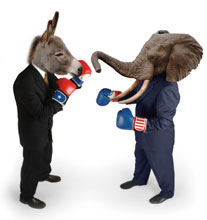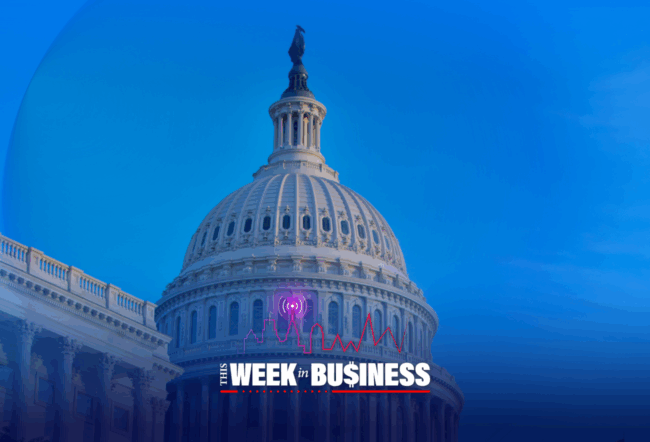Even with a friendlier Congress and conciliatory tones from the White House, businesses face major challenges in Washington as a still-weak economy makes it difficult for a divided government and various industries to push their agendas forward. The U.S. Chamber of Commerce has called for deficit reduction, restraints on government spending, lower taxes, fewer government regulations and improvements in education and infrastructure. In turn, the Obama Administration’s top request for businesses is to add more jobs.
But while most would agree that accomplishing at least some of these goals would be a positive step, a lot stands in the way of making them a reality. For one thing, the President is expected to remain at odds with the Republicans on many issues. For another, while the Republicans now control the House of Representatives, they still lack a majority in the Senate and the numbers needed to overcome a presidential veto of items like repealing the recent health care overhaul.
Businesses crave certainty and stability, because that kind of environment helps executives make long-range decisions about investment and hiring, which in turn leads to profitable growth. Thus, a government caught in a partisan standstill may not be all bad for business, notes Wharton management professor Peter Cappelli. “Even for Republicans, trying to drive big changes in policy is not something that the business community is going to like.”
But businesses may become caught in the middle if the government is unable to come to a consensus on issues like health care, taxes and the deficit. If the President and Congress cannot agree on what to do, executives are stuck in a waiting game to see how policies that directly affect their operations will play out.
The tight balance of power in Washington extends beyond the Senate and the House to a widespread network of lobbyists and players within government agencies, all of whom have their own agendas, notes Jason Wingard, vice dean of Executive Education at Wharton. In a closely divided environment marked by sharply opposing views, it is likely that neither side will get exactly what it wants. However, “if you fight to the point of death, neither side is going to win,” Wingard says.
Cries for civility have grown louder since the Tucson shootings that gravely wounded Arizona Congresswoman Gabrielle Giffords and killed six others. And there have been signs that Obama is taking steps to reduce the antagonism with the business community that existed during the first two years of his term. In addition to giving his blessing to an extension of the Bush-era tax credits, Obama appointed former JPMorgan Chase vice chairman William Daley as his new chief of staff. He also tapped GE CEO Jeffrey Immelt to head a new Council on Jobs and Competitiveness, which will advise the President on workforce expansion policies and on the establishment of a long-term growth strategy.
Next week, Obama plans to meet with officials at the U.S. Chamber of Commerce at the organization’s headquarters. The Chamber has devoted considerable time and money working to oppose much of Obama’s agenda, including the health care bill and the Dodd-Frank financial reforms: Leading up to the midterm elections, the Chamber spent more than $332 million on “issue ads” targeting Democrats who voted for those efforts, according to Bloomberg BusinessWeek, which noted that it will be just the third time that Obama has visited the Chamber, despite the fact that the group’s headquarters are only a short walk from the White House.
Creating Demand
Near double-digit unemployment rates hurt Democrats in the midterm elections, costing the party control of the House. Continued high unemployment could prevent President Obama from earning a second term in 2012. According to Cappelli, weak demand for goods and services continues to hold back growth for employers. They have little need to hire, and government incentives or retraining programs would probably have only a marginal impact on the jobless rate. With an official unemployment rate of 9.4%, and with far more people discouraged about seeking work or underemployed, companies have their pick of well-qualified workers for any spot that opens up. “Having the right skills is not really the problem. There are tons of people with the right skills out there,” says Cappelli. “Companies have figured out how to cut costs and do more with less. The amount of business they have is still not great enough to begin hiring.”
Business and government are trapped in an unfortunate cycle, notes Janet Pack, a Wharton business and public policy professor. While Republicans are calling for pullbacks on federal spending, the government can be a key source of demand to fuel private sector growth. The other potential demand-drivers — consumers, exports and private investment — are all currently too frail to jump-start business, Pack says. While Republican calls for deficit reduction and elimination of excessive regulation and government waste may be legitimate, Pack thinks those are issues that should be dealt with in the future. For the time being, she says, government spending is essential to keep the economic recovery alive. “Cutting demand is a crazy idea. It’s not what the economy needs right now.” Given vast overcapacity throughout the industrial sector, private demand will not rise without a huge tax cut, Pack points out. That, in turn, would make the deficit even larger. “We’ve got a real Catch-22 at this point.”
According to Pack, the $858 billion tax-cut compromise struck in the waning days of 2010 by Obama and a lame duck Congress will help companies generate needed demand. “To me, the continuation of the tax decrease was warranted,” she says. “How much demand it will stimulate, I’m not sure.”
Government investment in infrastructure as part of the Recovery and Reinvestment Act of 2009 has not had much impact on business, Pack notes, because projects such as road and sewer construction require several years to plan. A more immediate stimulus, she suggests, would come from federal government assistance to state and local governments that are cutting their workforces in the face of budget deficits. According to Pack, keeping those people employed would be an effective way to preserve demand and support the struggling economy.
After Obama presents his FY 2012 budget this month, the nation’s nearly $1.5 trillion deficit will likely be the focus of debate on spending and taxes, according to Kent Smetters, Wharton professor of insurance and risk management. Smetters says the question of whether to raise the debt ceiling — the Congressionally mandated cap on government spending — is also likely to be an early battle. Based on Treasury estimates, the current ceiling of $14.29 trillion will be reached by the end of March.
Smetters says the debt ceiling is a difficult issue because even the most aggressive budget-cutting scenarios do not eliminate enough spending to balance the budget in one year. Some members of Congress may demand limits, he says, but “it’s just posturing. They know it can’t be done.” However, he says Republicans could allow an increase of $1 trillion or so for just one year, but then refuse to raise the ceiling again for the next couple years. “This way, they can have some posturing that has some potential meaning,” including during the 2012 presidential election cycle.
According to Smetters, when it comes to taxes, neither side has a credible position. The administration would not be able to close the budget gap by taxing only the rich because there is not a big enough base. At the same time, raising taxes on the middle class is not politically feasible. He suggests one option might be to increase revenue through the “back door” by expanding the tax base. Smetters says an estimated 60% of GDP is not taxed largely as a result of historic practice. Possible targets could be tax exemptions for mortgage interest, charitable giving and employer medical spending. “All of these things significantly lower the tax base,” he notes. While it might be difficult to eliminate these provisions completely, legislators may be able to modify them, Smetters adds. For example, the government could allow a deduction for mortgages of up to perhaps $200,000, and then gradually phase it out for more expensive loans.
Indeed, in his State of the Union address, Obama suggested that by simplifying the tax system to take out loopholes — including tax breaks for big oil companies — the country could cut the overall corporate tax rate for the first time in 25 years without increasing the deficit.
The Case for Compromise
In one of its first official acts, the new Republican-controlled House of Representatives voted to repeal the transformative Patient Protection and Affordable Care Act (PPACA) signed into law by Obama last spring following bitter opposition from the U.S. Chamber of Commerce, Conservative lawmakers and other groups. While the repeal had no chance of getting through the Democratic Senate or past a Presidential veto, opponents will continue to press their case against the law, according to Wharton legal studies and business ethics professor Arnold Rosoff. He says the future of the reform legislation has moved beyond the legislative branch to the courts, where several federal legal challenges to the PPACA are underway. On January 31, a judge in Florida struck down the law, which is likely to face review by the U.S Supreme Court.
Repeal would be difficult now, Rosoff says, because voters are beginning to enjoy some of the benefits of the legislation, such as the ability to keep adult children up to age 26 on a parent’s coverage. While corporate managers typically have deeply held beliefs that the private sector is better equipped to cope with health care, he thinks businesses are more resigned to accept government reform today than in the past. After the failure of managed care to significantly reduce costs, employers shifted an increasing share of the health care burden onto employees, who now directly feel more of the pain of skyrocketing premiums. Consequently, workers blame their employers for the rising costs. While corporations may dislike the new law, they now take the attitude: “If the government fails, [workers] will be angry at the government and not us,” says Rosoff.
Some employers may find they will benefit from the new law, which calls for the establishment of state-run exchanges to create new insurance markets for individuals and small businesses. Smaller employers will be able to band together on exchanges and negotiate lower rates similar to what large corporations already receive from insurance providers. If they are able to offer comparable health benefits, small employers may be able to more effectively compete in the job market against big corporations. At the same time, Rosoff says the exchanges could spur workers who are afraid to quit jobs they dislike due to the loss of affordable health care benefits to leave their positions and seek a better match. That would in turn create more movement within the job market, and may encourage individuals to start their own businesses — another potential stimulus for the economy.
Jonathan Kolstad, a Wharton professor of health care management, says the shape of reform will also play out in the Department of Health and Human Services and other parts of the regulatory structure. “The rules they pick about how exchanges operate [will have] an important impact.” Rosoff adds that the White House may be open to listening to employers’ concerns in this arena. “The Obama administration has shown with the tax cut and other issues a willingness to reach some kind of compromise — a willingness that really ticks off the [extreme liberals] of his party. Obama would not sign a repeal of health care, but I think he might sign an amendment or modifications.”
Beyond health care, Obama issued an executive order in January giving managers throughout the government 120 days to root out ineffective business regulations that are not cost-effective or are “just plain dumb.” The U.S. Chamber, which estimates unnecessary regulation costs the U.S. economy $1.7 trillion a year, applauded Obama’s action. However, at the conclusion of its response, the Chamber took a swipe at two of Obama’s biggest legislative achievements, stating, “No major rule or regulation should be exempted from the review, including the recently enacted health care and financial reform laws.”
According to Wingard, the key to successful negotiations moving forward will be to establish priorities. For example, if the two sides have 10 issues on the table, perhaps three overlap and are therefore easily settled. Of the remaining seven, four may have the potential for compromise. Thus, the focus should turn to ways of ironing out differences on those issues in a way that allows each group to claim a win; the other three issues should be put on the back burner. “It is important for government to stay focused on the issues and how they relate to people, rather than just fighting on ideology,” Wingard says.



